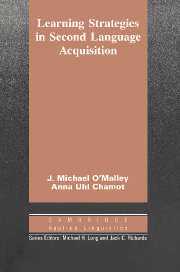Book contents
- Frontmatter
- Contents
- Series editors' preface
- Preface
- 1 Introduction
- 2 A cognitive theory of learning
- 3 How cognitive theory applies to second language acquisition
- 4 Learning strategies: methods and research
- 5 Strategies used by second language learners
- 6 Instruction in learning strategies
- 7 Learning strategies: models and materials
- 8 Summary and conclusions
- Glossary
- References
- Author index
- Subject index
5 - Strategies used by second language learners
Published online by Cambridge University Press: 05 October 2012
- Frontmatter
- Contents
- Series editors' preface
- Preface
- 1 Introduction
- 2 A cognitive theory of learning
- 3 How cognitive theory applies to second language acquisition
- 4 Learning strategies: methods and research
- 5 Strategies used by second language learners
- 6 Instruction in learning strategies
- 7 Learning strategies: models and materials
- 8 Summary and conclusions
- Glossary
- References
- Author index
- Subject index
Summary
In this chapter, we will build upon the review presented in Chapter 4 and describe a series of studies we performed that elicited both general and specific information about strategies, the students who use them, and the second language tasks with which the strategies are used. The first study attempted to define and classify strategies used in second language acquisition and used retrospective interviews with students learning English as a second language. The second study extended this purpose and again used retrospective interviews to identify strategies in second language acquisition but with native English-speaking students learning foreign languages. The third study was designed to build on the definitions and classifications established with retrospective interviews by using thinkaloud data collection to probe in greater depth the ways in which individual strategies are used by ESL students on a listening comprehension task. The final study reports the results of think-aloud interviews conducted longitudinally with students learning foreign languages.
Study 1: learning strategies used by beginning and intermediate ESL students
At the time we began our first study of learning strategies in second language acquisition, we were aware of most of the research discussed in the previous chapter, with the exception of a few specific studies using questionnaires in second language acquisition (e.g., Oxford 1986; Padron and Waxman 1988; Politzer and McGroarty 1985; Zimmerman and Pons 1986), which emerged later. There had been no studies performed of strategies used by students learning English as a second language, and no integration of the separate work performed in cognitive psychology and second language research.
Information
- Type
- Chapter
- Information
- Learning Strategies in Second Language Acquisition , pp. 114 - 150Publisher: Cambridge University PressPrint publication year: 1990
Accessibility standard: Unknown
Why this information is here
This section outlines the accessibility features of this content - including support for screen readers, full keyboard navigation and high-contrast display options. This may not be relevant for you.Accessibility Information
- 6
- Cited by
